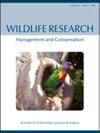稳定的澳洲野狗种群结构和纯度超过11年的致命管理
IF 1.6
3区 生物学
Q3 ECOLOGY
引用次数: 0
摘要
本文章由计算机程序翻译,如有差异,请以英文原文为准。
Stable dingo population structure and purity over 11 years of lethal management
ABSTRACT Context. Interaction between predators and humans is a key driver of human–wildlife conflicts, and can underpin management of predator populations. Management of the impacts of dingoes on livestock and native species is a prime example of a persistent and contentious predator management issue with potential impacts on the integrity of dingo populations. To manage the potential impacts of dingoes and their control, it is imperative to understand the effects of control approaches on their populations in the short and long term. Hybridisation of dingoes with domestic dogs also threatens the genetic integrity of pure dingoes. It has been hypothesised that lethal control of dingoes can facilitate hybridisation through disrupting pack social structures leading to increased dingo–domestic dog interactions. Aims. We aimed to to investigate how dingo population structure and genetic purity have changed, assessing dingo purity, individual relatedness, population clustering and gene flow, particularly across land use types and barrier fences, in the context of ongoing lethal control within the Murchison Regional Vermin Cell area in Western Australia (WA). Methods. We tested dingo genetic samples from three distinct sampling periods (2009, 2014 and 2020) for changes in population summary statistics and dingo ancestry. Barriers and corridors to gene flow were also examined. Key results. We identified three genetically distinct populations in the study area, consistent with previous genetic studies in WA. We did not find any evidence of change in dingo purity or population characteristics; however, barrier fencing may be influencing recent gene flow. Conclusions. The metapopulation of dingoes in the southern rangelands of WA appears to be stable over the 11 years assessed. Implications. Because we were unable to demonstrate that lethal control has accelerated hybridisation between dingoes and domestic dogs in the study area over the last 11 years, we have no evidence that lethal control to reduce losses to livestock production and for conservation of native wildlife in the southern rangelands of WA is putting dingo purity at risk. Fencing appears to be an effective management tool because there is some evidence it is congruent with reduced gene flow in areas where the fences are well maintained.
求助全文
通过发布文献求助,成功后即可免费获取论文全文。
去求助
来源期刊

Wildlife Research
生物-动物学
CiteScore
4.30
自引率
15.80%
发文量
56
审稿时长
3 months
期刊介绍:
Wildlife Research represents an international forum for the publication of research and debate on the ecology, management and conservation of wild animals in natural and modified habitats. The journal combines basic research in wildlife ecology with advances in science-based management practice. Subject areas include: applied ecology; conservation biology; ecosystem management; management of over-abundant, pest and invasive species; global change and wildlife management; diseases and their impacts on wildlife populations; human dimensions of management and conservation; assessing management outcomes; and the implications of wildlife research for policy development. Readers can expect a range of papers covering well-structured field studies, manipulative experiments, and analytical and modelling studies. All articles aim to improve the practice of wildlife management and contribute conceptual advances to our knowledge and understanding of wildlife ecology.
Wildlife Research is a vital resource for wildlife scientists, students and managers, applied ecologists, conservation biologists, environmental consultants and NGOs and government policy advisors.
Wildlife Research is published with the endorsement of the Commonwealth Scientific and Industrial Research Organisation (CSIRO) and the Australian Academy of Science.
 求助内容:
求助内容: 应助结果提醒方式:
应助结果提醒方式:


